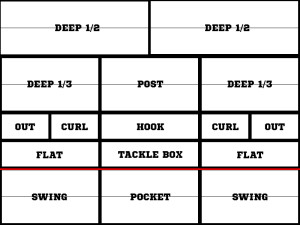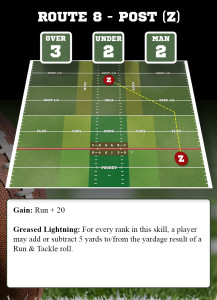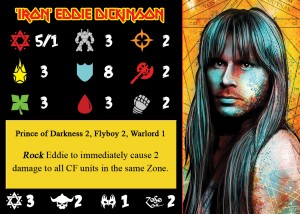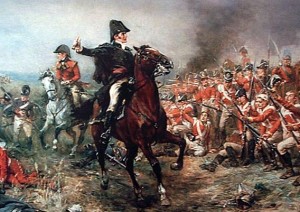Still trying to find a full time job 3 years after graduating with my MFA, so things have been slow on the gaming front, with little time to play, much less design, but here is the dirt on the projects at hand.
QUARTERBACK BLITZ
Now in it’s 9th revision, I have completely revised the game to use a smaller playing surface and simpler mechanics that still accurately represent professional football, but abstracted to speed up play considerably. The 1-1 field representation and UGO-IGO mechanics have been replaced by something that more closely resembles the chess match that is X vs.O in flow and visual components.
THE BOARD
 The board is now split into irregular areas that reflect how the offense mentally identifies the field. This makes plays easier to design and also helps to reduce the number of movement related skills.
The board is now split into irregular areas that reflect how the offense mentally identifies the field. This makes plays easier to design and also helps to reduce the number of movement related skills.
The Zone skill, for example is now unnecessary as the amount of segmentation decreases as one moves upfield, with board spaces becoming larger, allowing a Free Safety to cover the rear of the defense realistically.
THE PLAY SEQUENCE
Whereas before, I had each individual player taking an action during a turn, I have realized that the action in a play really can be divided into a sequence of three parts: 1. The Line Action, where interaction between the O and X lines determine the flow of the rest of the play; 2. Running Routes, where the rest of the Offense deploys to receive the ball and the defenders react to those deployments; and 3. The Resolution, in which the ball is released and the final results of the play are determined.
This greatly speeds up play, as it is no longer necessary to fuss with all 22 players during a single play. The results of 1. The Line might end up with a sack or a running play, eliminating the necessity of dealing with steps 2 and 3. Similarly, the results of the line limits how many players the offense gets to deploy before they must pass the ball, and certain timing passes will force the ball to be thrown immediately, again, eliminating the need to waste time fiddling with non-active players. And Step 3. The Resolution, is now a simple roll off on a table to determine final yardage instead of the back and forth moving of miniatures until the ball carrier is brought down or reaches the end zone.
THE CARD
Building plays is now easier with a system of offensive and  defensive cards that focus on particular parts of the play sequence and certain areas of the field. A coach’s hand will consist of a number of cards (7 on average) which can include a combination of Play cards (routes, defensive structures, etc. as seen on the right) and Action Cards (special events and skill usage).
defensive cards that focus on particular parts of the play sequence and certain areas of the field. A coach’s hand will consist of a number of cards (7 on average) which can include a combination of Play cards (routes, defensive structures, etc. as seen on the right) and Action Cards (special events and skill usage).
Rules for skills are now presented in a more usable format: Instead of having to memorize skill lists with tons of exceptions, all the info needed to play will be on the particular card used (both play and action). This makes the game easier and faster to play and allows for a smaller number of broader skills with a greater variety of uses.
BARBARIANS OF HEAVY METAL: THE CARD GAME
 This is actually pretty close to done. In play-testing, the mechanics seem to work extremely well at recreating miniature wargaming with cards.
This is actually pretty close to done. In play-testing, the mechanics seem to work extremely well at recreating miniature wargaming with cards.
I want to redo the armor rules and tighten up the mechanics for building Titans, to speed up play and reduce complexity a bit. Also, I’m considering how to simplify the card types to cut down on clutter.
DONJONS & DRAGOONS
 Just before finishing Bone Orchard, I went off table top RPGs and hung up my hat as a designer in that area. The customer base was too segmented and the profit to cost ratio was poor, but mostly, I just didn’t enjoy it anymore. It might have helped if there was a subject that really grabbed my attention and hadn’t been thoroughly explored yet, or if the RPG market was even slightly interested in any of my more outlandish and niche projects like BoHM.
Just before finishing Bone Orchard, I went off table top RPGs and hung up my hat as a designer in that area. The customer base was too segmented and the profit to cost ratio was poor, but mostly, I just didn’t enjoy it anymore. It might have helped if there was a subject that really grabbed my attention and hadn’t been thoroughly explored yet, or if the RPG market was even slightly interested in any of my more outlandish and niche projects like BoHM.
Flash forward 2 years and I’ve picked up an interest in the Georgian Era, and Napoleonics. After a lot of reading over the last year or so, I am inspired to do another RPG based on that period. This time the interest is an academic one, however. I want to make what I believe the first RPG would have looked like if I had been at the forefront of that design instead of Gygax and Arneson. What would it look like if I had created the first RPG, based on Napoleonic wargames instead of fantasy, and based on my particular design ethos and predilections?
So I’m slowly, over time and in between working on other things, building an RPG based on the period, based on the 3 booklet structure of the original D&D game, but with rules of my own,which will be more heavily inspired by the refereed narrative of the Braunstein games of David Wesley rather than the more mechanistic Chainmail rules. It’s one part academic exercise, one part keeping my design skills sharp and one part trying to finish something less graphically and workload intensive than my other two projects.
There is another motive: I am looking to create a video channel on games and game design and I think this would make an interesting subject for a ‘How To Write an RPG’ series of videos for that channel. But more on that later….

